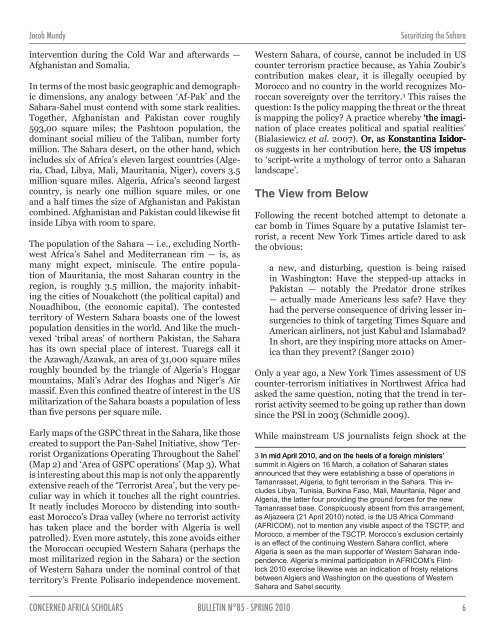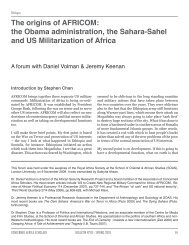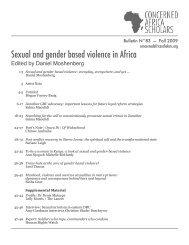Western Sahara and the United States' geographical imaginings
Western Sahara and the United States' geographical imaginings
Western Sahara and the United States' geographical imaginings
You also want an ePaper? Increase the reach of your titles
YUMPU automatically turns print PDFs into web optimized ePapers that Google loves.
Jacob Mundy Securitizing <strong>the</strong> <strong>Sahara</strong><br />
intervention during <strong>the</strong> Cold War <strong>and</strong> afterwards —<br />
Afghanistan <strong>and</strong> Somalia.<br />
In terms of <strong>the</strong> most basic geographic <strong>and</strong> demographic<br />
dimensions, any analogy between ‘Af-Pak’ <strong>and</strong> <strong>the</strong><br />
<strong>Sahara</strong>-Sahel must contend with some stark realities.<br />
Toge<strong>the</strong>r, Afghanistan <strong>and</strong> Pakistan cover roughly<br />
593,00 square miles; <strong>the</strong> Pashtoon population, <strong>the</strong><br />
dominant social milieu of <strong>the</strong> Taliban, number forty<br />
million. The <strong>Sahara</strong> desert, on <strong>the</strong> o<strong>the</strong>r h<strong>and</strong>, which<br />
includes six of Africa’s eleven largest countries (Algeria,<br />
Chad, Libya, Mali, Mauritania, Niger), covers 3.5<br />
million square miles. Algeria, Africa’s second largest<br />
country, is nearly one million square miles, or one<br />
<strong>and</strong> a half times <strong>the</strong> size of Afghanistan <strong>and</strong> Pakistan<br />
combined. Afghanistan <strong>and</strong> Pakistan could likewise fit<br />
inside Libya with room to spare.<br />
The population of <strong>the</strong> <strong>Sahara</strong> — i.e., excluding Northwest<br />
Africa’s Sahel <strong>and</strong> Mediterranean rim — is, as<br />
many might expect, miniscule. The entire population<br />
of Mauritania, <strong>the</strong> most <strong>Sahara</strong>n country in <strong>the</strong><br />
region, is roughly 3.5 million, <strong>the</strong> majority inhabiting<br />
<strong>the</strong> cities of Nouakchott (<strong>the</strong> political capital) <strong>and</strong><br />
Nouadhibou, (<strong>the</strong> economic capital). The contested<br />
territory of <strong>Western</strong> <strong>Sahara</strong> boasts one of <strong>the</strong> lowest<br />
population densities in <strong>the</strong> world. And like <strong>the</strong> muchvexed<br />
‘tribal areas’ of nor<strong>the</strong>rn Pakistan, <strong>the</strong> <strong>Sahara</strong><br />
has its own special place of interest. Tuaregs call it<br />
<strong>the</strong> Azawagh/Azawak, an area of 31,000 square miles<br />
roughly bounded by <strong>the</strong> triangle of Algeria’s Hoggar<br />
mountains, Mali’s Adrar des Ifoghas <strong>and</strong> Niger’s Aïr<br />
massif. Even this confined <strong>the</strong>atre of interest in <strong>the</strong> US<br />
militarization of <strong>the</strong> <strong>Sahara</strong> boasts a population of less<br />
than five persons per square mile.<br />
Early maps of <strong>the</strong> GSPC threat in <strong>the</strong> <strong>Sahara</strong>, like those<br />
created to support <strong>the</strong> Pan-Sahel Initiative, show ‘Terrorist<br />
Organizations Operating Throughout <strong>the</strong> Sahel’<br />
(Map 2) <strong>and</strong> ‘Area of GSPC operations’ (Map 3). What<br />
is interesting about this map is not only <strong>the</strong> apparently<br />
extensive reach of <strong>the</strong> ‘Terrorist Area’, but <strong>the</strong> very peculiar<br />
way in which it touches all <strong>the</strong> right countries.<br />
It neatly includes Morocco by distending into sou<strong>the</strong>ast<br />
Morocco’s Draa valley (where no terrorist activity<br />
has taken place <strong>and</strong> <strong>the</strong> border with Algeria is well<br />
patrolled). Even more astutely, this zone avoids ei<strong>the</strong>r<br />
<strong>the</strong> Moroccan occupied <strong>Western</strong> <strong>Sahara</strong> (perhaps <strong>the</strong><br />
most militarized region in <strong>the</strong> <strong>Sahara</strong>) or <strong>the</strong> section<br />
of <strong>Western</strong> <strong>Sahara</strong> under <strong>the</strong> nominal control of that<br />
territory’s Frente Polisario independence movement.<br />
CONCERNED AFRICA SCHOLARS BULLETIN N°85 - SPRING 2010<br />
<strong>Western</strong> <strong>Sahara</strong>, of course, cannot be included in US<br />
counter terrorism practice because, as Yahia Zoubir’s<br />
contribution makes clear, it is illegally occupied by<br />
Morocco <strong>and</strong> no country in <strong>the</strong> world recognizes Moroccan<br />
sovereignty over <strong>the</strong> territory. 3 This raises <strong>the</strong><br />
question: Is <strong>the</strong> policy mapping <strong>the</strong> threat or <strong>the</strong> threat<br />
is mapping <strong>the</strong> policy? A practice whereby ‘<strong>the</strong> imagiimagination of place creates political <strong>and</strong> spatial realities’<br />
(Bialasiewicz et al. 2007). Or, as Konstantina Isidor-<br />
Isidor- Isidor-<br />
os suggests in her contribution here, <strong>the</strong> US impetus<br />
to ‘script-write a mythology of terror onto a <strong>Sahara</strong>n<br />
l<strong>and</strong>scape’.<br />
The View from Below<br />
Following <strong>the</strong> recent botched attempt to detonate a<br />
car bomb in Times Square by a putative Islamist terrorist,<br />
a recent New York Times article dared to ask<br />
<strong>the</strong> obvious:<br />
a new, <strong>and</strong> disturbing, question is being raised<br />
in Washington: Have <strong>the</strong> stepped-up attacks in<br />
Pakistan — notably <strong>the</strong> Predator drone strikes<br />
— actually made Americans less safe? Have <strong>the</strong>y<br />
had <strong>the</strong> perverse consequence of driving lesser insurgencies<br />
to think of targeting Times Square <strong>and</strong><br />
American airliners, not just Kabul <strong>and</strong> Islamabad?<br />
In short, are <strong>the</strong>y inspiring more attacks on America<br />
than <strong>the</strong>y prevent? (Sanger 2010)<br />
Only a year ago, a New York Times assessment of US<br />
counter-terrorism initiatives in Northwest Africa had<br />
asked <strong>the</strong> same question, noting that <strong>the</strong> trend in terrorist<br />
activity seemed to be going up ra<strong>the</strong>r than down<br />
since <strong>the</strong> PSI in 2003 (Schmidle 2009).<br />
While mainstream US journalists feign shock at <strong>the</strong><br />
3 I� I� m�� m�� Ap��� Ap��� 0 0, ��� ��� �� �� ����� ����� ��������� ��������� �� �� � � �������� �������� m�����������’ m�����������’<br />
���mm�� �� A�������� �� 6 M�����, � ��������� �� S������� ���������<br />
���������� ����� �����y w����� ������b��������� � b����� �� �p���������� ��<br />
T�m�����������, A�������, �� ������ ����������m �� ����� S������. T����� ���<br />
�������� ��by�, T�������, B��k��� F����, M���, M���������, N����� ���<br />
A�������, ����� ������� ���� p��v����� ����� ������ �������� ��� ����� ���w<br />
T�m����������� b�����. C����p��������y �b������ ���m ������ ��������m����,<br />
��� A�j�������� � Ap��� 0 0�� ������, ��� ����� US A����� C�mm���<br />
�AFRIC�M��, ��� �� m������� ��y v����b��� ���p���� �� ����� TSCTP, ���<br />
M������, � m��mb��� �� ����� TSCTP. M������’�� ��x�������� ���������y<br />
��� �� �������� �� ����� ���������� W��������� S������ ��������, w�������<br />
A������� ��� ������� ��� ����� m��� ���pp������ �� W��������� S������� ������<br />
p����������. A�������’�� m���m�� p������p����� �� AFRIC�M’�� F�����<br />
���k 0 0 ��x��������� ��k��w����� w��� �� ���������� �� ������y �����������<br />
b���w����� A�������� ��� W����������� �� ����� q����������� �� W���������<br />
S������ ��� S������ ���������y.




